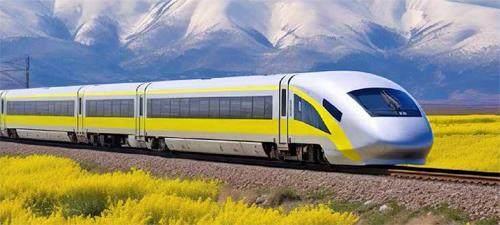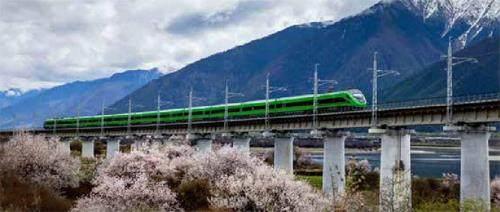坐火车去拉萨
朱迪特


青藏铁路是世界上海拔最高、線路最长的高原铁路,与“南水北调”“西气东输”“西电东送”并称为“中国新世纪四大工程”。2023 年7 月1 日起,东起西宁站、西至格尔木站的青藏铁路正式进入动车时代,时速从原来的每小时140 公里提升至每小时160 公里,运输能力和服务质量也都得到大幅度提升。 至此,“坐火车去拉萨”成为许多人说走就走的旅行。
The Qinghai-Tibet Railway, also known asthe Qingzang Railway, is the highest-altitude andlongest plateau railway in the world. It is one of the“Four Great Projects of China in the New Century,”alongside the South-to-North Water Diversion, West-East Gas Transmission, and West-East ElectricityTransmission projects. Starting from July 1, 2023, theQinghai-Tibet Railway, which runs from Xining in theeast to Golmud in the west, has entered an era of highspeedtrains. The train speed was increased from theoriginal 140 kilometers per hour to 160 kilometers perhour, with significant improvements on transportationcapacity and service quality. As a result, “taking thetrain to Lhasa” has become a worry-free travel formany at any time they wish.
一站一景
Unique Scenery at Every Stop
坐火车从西宁出发,大约一小时,便来到了青海湖。青海湖是中国最大的内陆湖泊,从远处眺望,海天一色,水天相接。七、八月时,环湖的千亩油菜花竞相绽放,给碧波荡漾的湛蓝湖面点缀上一簇簇耀眼的金黄。
Setting off from Xining by train, you will arrive at Qinghai Lake in about an hour. QinghaiLake is China’s largest inland lake, and when viewed from afar, it appears as if the lake joins thesky. In July and August, thousands of acres of rapeseed flowers bloom around the lake, adorningthe deep blue waters with clusters of dazzling golden yellow.
离开青海湖,再坐三小时便到了德令哈站。“德令哈”是蒙古语,意为“金色的原野”。经过此地,窗外是一望无际的盐碱地、大片的红柳、荒凉的戈壁,让人恍如置身于西部大片之中。
Leaving Qinghai Lake, after another three hours, you will reach Delingha Railway Station.“Delingha” means “the golden grassland” in Mongolian. Passing through this region, you’ll findyourself wandering in the scenery of those western movies when you look out of the windowand see vast salt flats, extensive red willow forests, and desolate Gobi landscapes.
乘火车一路向西,经过昆仑山,再往南,就是被藏族人喻为“美丽的少女”的可可西里。境内江河纵横,湖泊星罗棋布。这里还是高原野生动物的“王国”。幸运的话,你可以看到成群的藏羚羊在自由地奔跑、觅食。
Continuing westward by train, passing through the Kunlun Mountains and heading south,you arrive at Hoh Xil, known to the Tibetan people as the “beautiful maiden.” The region iscrisscrossed with rivers and dotted with lakes. It’s also a “kingdom” for high-altitude wildlife. Ifyou’re lucky, you might spot herds of Tibetan antelopes running and grazing freely.
天地自己
A World of Its Own
常在低海拔地区居住的人们,来到青藏高原很有可能会出现一些高原反应。坐在从青海西宁到西藏拉萨的火车上,随着海拔一点点升高,到3 000 米以上的时候,有的人就会感觉头晕、头疼、心慌,但此时此刻,窗外的美景会让人们忘记身体的不适。窗外那红黄色的江水,好似人的血管,错综复杂,蜿蜒曲折地分布在广阔的土地上。与奔腾流淌的长河相比,巨大的火车好像变成了一条小船在河流上漂荡。抬头望向湛蓝的天空,仿佛伸手就能碰到洁白的云彩。不时有一两只大鸟飞落在远处的溪边,休憩戏水,不一会儿工夫,又张开双翅,飞上蓝天。远处草地上不时出现一些小动物的身影,从河边一跃而过,如同精灵一般,倏地出现,忽地又不见了。
People who are accustomed to living at low altitudes may experiencesome altitude sickness when travelling to the Qinghai-Tibet Plateau. Asyou sit on the train from Xining to Lhasa and the altitude gradually rises,reaching over 3,000 meters, some may feel dizzy, have headaches, orexperience palpitations. However, at moments like this, the breathtakingscenery outside the window helps people forget the discomfort. The redand yellow rivers resemble human veins, intricately winding across thevast land. Compared with the rushing rivers, the massive train seems likea small boat drifting on the water. Looking up at the deep blue sky, youfeel like you could reach out and touch the pristine clouds. Every now andthen, a few large birds land by a distant stream, taking a break and playingin the water. In no time, they spread their wings and soar into the bluesky again. On the distant grasslands, you may see the fleeting figures ofsmall animals leaping from the riverbank, like elves, appearing suddenlyfrom and disappearing just as quickly into the sky.
就這样一路坐着火车,慢慢地驶离城市的喧嚣与拥挤,一点点地与大自然的宁静与宽广相拥。西藏的每一处风景,都让我们的心慢下来,接受洗涤、净化。它独特的自然与人文景观吸引着无数中外游客像一个个虔诚的信徒,不远万里来到此地。
Travelling on this train, you gradually leave behind the noise andcrowds of the city, embracing the tranquility and vastness of nature. Everylandscape in Tibet slows your heart down, cleansing and purifying it.Its unique natural and cultural scenery attracts countless domestic andinternational tourists, who come from afar like devoutbelievers, overcoming all obstacles to reach thisplace.
排除万难
Overcoming Countless Challenges
随着青藏铁路步入动车时代,火车提速将吸引更多的游客前往西藏,一览高原的独特风光。往来飞驰的列车,让高原不再遥不可及;纷至沓来的商旅游客,也推动着边疆的开发与经济的发展。
With the advent of high-speed trains on theQinghai-Tibet Railway, the increased speed willattract more tourists to Xizang, allowing them towitness the unique plateau scenery. The fast trainshave made the remote plateau more accessible,and the influx of business and tourist travellers isdriving the development of the border region andthe local economy.
然而,青藏铁路卓越成就的背后,是多少建设者付出的生命与汗水。他们凭借智慧与勇气克服了自然环境的重重艰险和技术设备的层层壁垒。
However, behind the remarkable achievementof the Qinghai-Tibet Railway lie the sacrificesof many who dedicated their lives and sweat.With wisdom and courage, they overcame thechallenges of the harsh natural environment andtechnical barriers.
青藏铁路的建设面临着多年冻土、高寒缺氧、生态脆弱“三大难题”的严峻挑战。多年冻土,意味着这些土在夏天会随着气温升高而融沉,冬天会随着气温降低而冻胀,处理不好,路基随时都会坍塌;高寒缺氧、生态脆弱,意味着在这里施工,建设者在承受高强度的体力劳动的同时,还随时可能出现缺氧症状。在青藏铁路的建设过程中,有多少人为这条铁路献出了自己宝贵的生命,又有多少人把自己的美好年华献给了高原的荒凉之境。
The construction of the Qinghai-TibetRailway faced severe challenges, includingpermafrost, high-altitude hypoxia, and thefragility of the ecosystem. Permafrost means thatthe soil here thaws and subsides in the summeras temperatures rise and freezes and swells inthe winter as temperatures drop. As a result,the roadbed could collapse at any time withoutproper solution. High-altitude hypoxia and thefragility of the ecosystem mean that workershad to endure strenuous physical labor whileconstantly facing the risk of hypoxia. Manypeople gave their lives for this railway during theconstruction, and many others dedicated theiryouthful years to the harsh wilderness of theplateau.
既然青藏铁路的建设这么难,那为什么还是要坚持建设呢?自古以来,青藏高原对中华民族的生存与发展都有着重要意义。它是亚洲众多大江大河的发源地,黄河、长江、印度河、恒河都源于此,这里也因此被誉为“亚洲文明水塔”。但壮美的高原和雪山,也成为阻隔西藏与外界联系的天堑。千百年来,因交通闭塞,里面的人走不出来,外面的人走不进去。
Given the challenges, why did they persist inbuilding the Qinghai-Tibet Railway? The Qinghai-Tibet Plateau has always been of great significance tothe Chinese nation’s survival and development. It isthe source of many of Asia’s major rivers, including theYellow River, Yangtze River, Indus River, and GangesRiver, earning it the title of the “Water Tower of Asian Civilization.” Yet the majestic plateau and snowymountains have also acted as a natural barrier, isolatingXizang from the outside world. For thousands of years,due to its isolation, people inside couldn’t venture out,and people outside couldn’t get in.
60 多年前,青藏高原尚無半寸铁路,“茶马古道”上的悠悠驼铃记载了那个时代的沧桑艰难。中华人民共和国成立后,两万峰骆驼组建成一支西藏骆驼运输队,专门用于内地和西藏间的物资运输。但由于自然条件恶劣,驼队每行进一公里,就要留下12 具骆驼的尸体。即使后来修建了两条进藏公路,其运输能力仍远不尽如人意。只有铁路通了,才能真正解决交通问题。
More than 60 years ago, there was no railwayon the Qinghai-Tibet Plateau, and the jinglingbells of camels on the Ancient Tea-Horse Road borewitness to the hardships of that era. After the foundingof the People’s Republic of China, 20,000 camelswere organized into a Tibetan camel transport team,dedicated to transporting goods between the inland andXizang. However, due to the harsh natural conditions,for every kilometer travelled, the camel team wouldleave behind 12 dead camels. Even after two roadsinto Xizang were built later on, their transportationcapacity still fell far short. Only with a railway could thetransportation problem be truly solved.
1958 年5 月,青藏铁路的起源—兰青铁路,在兰州河口和青海西宁等多地同时破土开建。经过铁路建设者和五万多名青海当地百姓16 个月的风雨鏖战,1959 年9 月,全长188 公里的兰青铁路全线贯通。从此,青海结束了没有铁路的历史。
In May 1958, the origin of the Qinghai-TibetRailway, the Lan-Qing Railway, began constructionsimultaneously in multiple locations, including Hekouof Lanzhou, and Xining of Qinghai. After 16 monthsof arduous efforts by railway builders and more than50,000 local Qinghai residents, the 188-kilometerLan-Qing Railway was completed in September 1959,marking the end of Qinghai’s history without a railway.
然而,铁路通车的背后所克服的技术难题是难以想象的。美国旅行家保罗 · 泰鲁曾断言:“有昆仑山脉在,铁路就永远到不了拉萨。”
However, the technical challenges behind therailway are unimaginable. American traveller PaulTheroux once asserted, “As long as the KunlunMountains stand, a railway will never reach Lhasa.”
青藏线大部分线路处于高海拔地区和“生命禁区”,拿生态环境保护来说,青藏铁路穿越了多个国家级自然保护区,生态环境异常脆弱。为了保护高原湛蓝的天空、清澈的湖水、珍稀的野生动物,铁路建设首次为野生动物开辟迁徙通道。而在自然保护区内,铁路线路则遵循“能绕避就绕避”的规划原则。因此,大批藏羚羊得以自由迁徙。青藏铁路开工建设以来,沿线冻土、植被、湿地环境、自然景观、江河水质等,都得到了有效保护,青藏高原生态环境未受明显影响。
Most of the Qinghai-Tibet Railway traverses highaltituderegions and what are considered “dead zones.”Speaking of environmental protection, the Qinghai-Tibet Railway passes through multiple national-levelnature reserves where the ecological environmentis exceptionally fragile. In order to safeguard thepristine blue skies, lucid lakes, and rare wildlife ofthe plateau, the railway construction opened upmigration corridors for wild animals for the firsttime. Within these natural reserves, the railway routefollows the planning principle of “avoidance wheneverpossible.” As a result, significant populations of Tibetan antelopes have been able to migrate freely. Since thecommencement of the railway construction, thepermafrost, vegetation, wetland environments, naturallandscapes, river water quality, and more along theroute have all received effective protection, ensuringthat the ecological environment of the Qinghai-TibetPlateau has not suffered significant impacts.
现如今,铁路系统仍在不断升级。迈入动车时代后,铁路再次提质增速。神奇的“天路”把人间的温暖送到边疆。中华各民族之間的联系也因此更加紧密,亲如一家。“从此,山不再高,路不再漫长,各族儿女欢聚一堂”。
Nowadays, the railway system is continuouslyupgrading, and with the advent of high-speed trains,the railway is once again improving in quality andspeed. The miraculous “Sky Road” brings the warmthof the world to the borderlands. The connectionbetween China’s various ethnic groups is becomingcloser consequently, like one big family. As sung inthe song “Qingzang Gaoyuan” (“The Qinghai-TibetPlateau”), “From now on, the mountains are no longerhigh, and the roads are no longer long. People of allethnic groups have a joyous gathering.”

